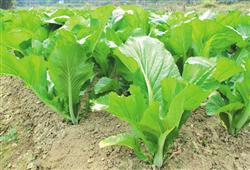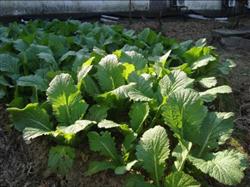How to grow mustard in winter?

How to grow mustard in winter? Please introduce large mustard, also known as heart mustard, meat mustard, cruciferous, long-day crops, sexual like cold, wet climate conditions, but not resistant to frost. Its meat is thick, sweet and delicious, and can be fried with meat, especially suitable for processing such as pickled sauerkraut. The product has a unique taste and good color and taste. It can be used not only as a side dish on the table, but also as a side dish for cooking, stir-frying and braising. First, the cultivation season. The suitable temperature for the growth of large mustard in winter is 1525 ℃. Generally, the seedling transplanting method should be sown from the end of October to the end of October (the bed seedling stage is about 20 days). It is usually planted after late rice harvest, that is, in mid-November (before Lesser Snow), and harvested from the end of January to early February the following year. The field growth period is 75-85 days, and the average yield per mu is 4000-5000 kg. Second, garden site selection and planning. Choose neutral loam, convenient drainage and irrigation, good water quality farmland planting, build deep ditch high border, east-west direction is better, border width 1.2 to 1.25 meters bag ditch. When preparing the land for bed, 15002000 kg of rotten organic fertilizer was applied per mu, and 40kg of N, P, K compound fertilizer was used as base fertilizer. Third, sowing and raising seedlings. In order to improve the land utilization rate, seedling transplanting is generally adopted. The seedling bed is covered with roasted pond mud (or fertile gully soil). The seedbed is 3 square meters per mu, the amount of seed is 5 grams, and the finger points of 2500 to 2600 are pressed with hands. The specification of each hole is 3 cm × 3 cm. Sow 1 seed in each hole, and the seed is covered with thin soil after sowing. Fourth, transplant and colonize. Double row planting, row spacing 60 cm, plant spacing 41.6 cm, plant spacing 43.3 cm, about 2100 plants per mu. Adopt the method of seedling transplanting, transplant with soil, and get rid of stiff seedlings, weak seedlings and diseased seedlings. After 1 week of planting, 0.5% urea (or compound fertilizer) aqueous solution was used to drench the seedlings 2 or 3 times every 3 days. In order to improve the survival rate and accelerate the return to green and early hair, the seedlings can be drenched with "802" or "Runshengbao" after planting, and check the seedlings in time to make up for them. Fifth, soil, fertilizer and water management. After transplanting, straw was used to cover the gap between seedlings to keep the soil moist. Fertilization should pay attention to making relay fertilizer, apply compound fertilizer once a week in the first 30 days, 15 kg per mu, and every 10 days after 30 days. Compound fertilizer should be applied at 100kg to 125kg during the whole period. Under normal climatic conditions, water needs to be irrigated through ditches with shallow water for 7 to 8 times. Sixth, pest prevention and control. In the early stage, leaf moths, cabbage insects, aphids and planthoppers were more common. In the later stage (after the early stage of Baoxin), disease prevention was the center, mainly downy mildew, virus disease and root swelling disease. In order to prevent the occurrence of disease after budding, "panicle toxic mold" or "Jinggangmycin" was sprayed every 5-7 days. Matters needing attention. (1) waterlogging prevention and timely drainage in rainy days; (2) shallow water and foliar spraying water should be irrigated when strong north wind is blowing; (3) prevention of diseases should be strengthened in case of high temperature and humidity. Click to get more mustard planting techniques click to get more vegetable planting techniques
- Prev

How to grow root mustard?
How to grow root mustard? What should I pay attention to? Please guide the planting and management of root mustard can refer to the following methods: (1) during the cultivation season, root mustard is sown in autumn, regardless of north and south. The autumn sowing is earlier in the areas with faster cooling in autumn and severe cold in winter, and later in the areas with slower cooling and less cold in winter. From China.
- Next

How to grow big leaf mustard?
How to grow big leaf mustard? Please guide the planting methods of large-leaf mustard can refer to the following: 1) cultivation season. Large-leaf mustard is suitable for planting in autumn and spring protected areas in northern China. Autumn seeds are usually sown from August to October, harvested from October to November, sown in spring from January to February, and grow to one plant in March to April.
Related
- Where is it suitable to grow horseradish in China? it is expected to see the middle altitude horseradish in Alishan.
- How to prevent tomato virus disease reasonably? (Control methods included)
- Many people like to plant towel gourd on the balcony. What are the main points of this method and management?
- What crops can chili peppers be mixed with?
- Fertilization techniques and matters needing attention in Tomato
- What are the grafting techniques for peach seedlings in spring?
- Harm and control methods of root swelling disease of Chinese cabbage
- What are the pests of sweet potatoes? How to prevent and cure it?
- Symptoms, causes and Control methods of navel Rot in Tomato
- The cause of "Cucumber rotten bibcock" in Farmers' planting Cucumber and its Control Plan

